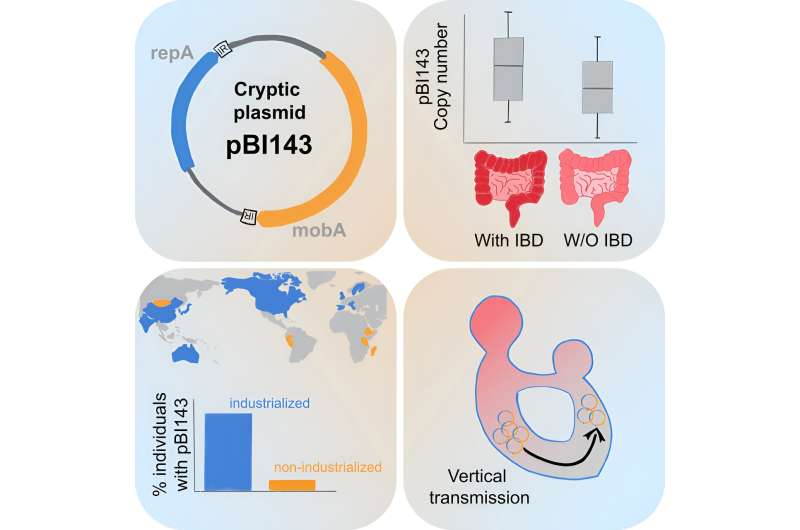This article has been reviewed according to Science X's editorial process and policies. Editors have highlighted the following attributes while ensuring the content's credibility:
fact-checked
peer-reviewed publication
proofread
Researchers find cryptic genetic element in the human gut that could serve as a sensitive biomarker

A component of the human intestinal flora that has been little studied to date is the focus of a new study from Germany. Plasmids are small extrachromosomal genetic elements that frequently occur in bacterial cells and can influence microbial lifestyles—yet their diversity in natural habitats is poorly understood.
An international team led by Prof. Dr. A. Murat Eren from the Helmholtz Institute for Functional Marine Biodiversity at the University of Oldenburg (HIFMB) reports in the journal Cell that a mysterious plasmid is one of the most numerous genetic elements in the human gut.
This plasmid could potentially serve as a powerful biomarker for identifying health hazards such as fecal contamination of water or human disorders such as inflammatory bowel disease. According to the team's analyses, this plasmid is present in the intestines of more than 90% of individuals in industrialized countries.
Plasmids are extrachromosomal DNA sequences that are common to cells from all domains of life. Eren describes them as "typically small genetic entities that carry additional genes." They can be exchanged between different bacterial cells and even between different types of bacteria. The replication of plasmids is dependent on their host cells, but they make up for it by providing their hosts with in some cases extremely important fitness determinants.
For instance, some plasmids contain genes that encode antibiotic resistance, which help their bacterial hosts to survive antibiotics, contributing to one of the most pressing public health concerns around the globe.
There are also other plasmids that, according to the research to date, do not contain genes encoding obvious beneficial functions for their host. "These so-called 'cryptic plasmids' are often referred to as genetic parasites. They remain a mystery in microbial ecology because from an evolutionary perspective they should not exist at all," explains Eren, a computer scientist and Professor of Ecosystem Data Science at the University of Oldenburg.
Identifying plasmids has been a difficult undertaking so far. For some time now, scientists have been able to extract genetic material directly from environmental samples and, for example, analyze the microbial community in the human gut in its entirety, without having to cultivate individual bacterial organisms. However, the ability to confidently distinguish what is a plasmid among this conglomeration of genetic material, referred to as the metagenome, poses a considerable challenge.
To solve this problem, Eren and his colleagues developed a new machine learning approach. As the team reports in another article, this one recently published in Nature Microbiology, they used this approach to identify more than 68,000 plasmids in human intestinal flora and also discovered that a certain cryptic plasmid called pBI143 was particularly abundant in their dataset.
In the study published in Cell, the team of researchers took a closer look at this plasmid, which consists of only two genes that rather surprisingly only serve for its own replication and mobilization across bacterial cells with no other clear benefit. To better understand the ecology of pBI143, the team analyzed 60,000 human and 40,000 environmental metagenomes generated from various habitats.
"We found that pBI143 has a list of very interesting features," Eren explains. The team discovered that more than 90% of people in industrialized countries carry the plasmid and that on average it is one of the most numerous genetic entities in the human gut. "On average, it was more than 10 times as numerous as a viral genome which was previously thought to be the most abundant genetic extrachromosomal element in the human gut," says the researcher.
Further analyses revealed that the plasmid occurred almost exclusively in the human gut but was virtually absent in datasets from other environments such as the oceans, soils, plants and the digestive organs of animals and their feces. The only other samples in which the researchers were able to detect the characteristic gene sequence for these plasmids was in samples from environments that are influenced by humans, such as wastewater, hospital surfaces and laboratory rats.
Due to its sheer numbers, prevalence across humans, and its conservancy across human populations, the team of researchers hypothesized that pBI143 could, for instance, be used as a biomarker in testing for fecal contamination. "In fact, we were able to show that this plasmid is a more sensitive marker for detecting fecal contamination in drinking water compared to state-of-the-art biomarkers based on specific gene sequences of human intestinal bacteria," says Eren.
The team also identified another potential application of this prevalent genetic entity in the context of human disorders such as inflammatory bowel disease (IBD), a medical condition that affects 3 million people in Europe alone. They were able to demonstrate that the relative copy number of this cryptic plasmid increased almost four times in the intestines of people suffering from IBD compared to the intestines of healthy individuals, suggesting that the changes of the copy number of the plasmid can serve as a non-invasive method to quantify the disease progress or severity.
At the HIFMB, Eren's team is developing new tools at the intersection of computer science and microbiology to identify and characterize naturally occurring plasmids and other mobile genetic elements in bacteria that live in the ocean. They strive to gain a better understanding of the ecology and evolution of microbes, and strategies that enable them to respond to their everchanging environments for new biotechnological applications that can ameliorate crises we face.
More information: Emily C. Fogarty et al, A cryptic plasmid is among the most numerous genetic elements in the human gut, Cell (2024). DOI: 10.1016/j.cell.2024.01.039
Michael K. Yu et al, Diverse plasmid systems and their ecology across human gut metagenomes revealed by PlasX and MobMess, Nature Microbiology (2024). DOI: 10.1038/s41564-024-01610-3
Journal information: Nature Microbiology , Cell
Provided by Carl von Ossietzky-Universität Oldenburg





















